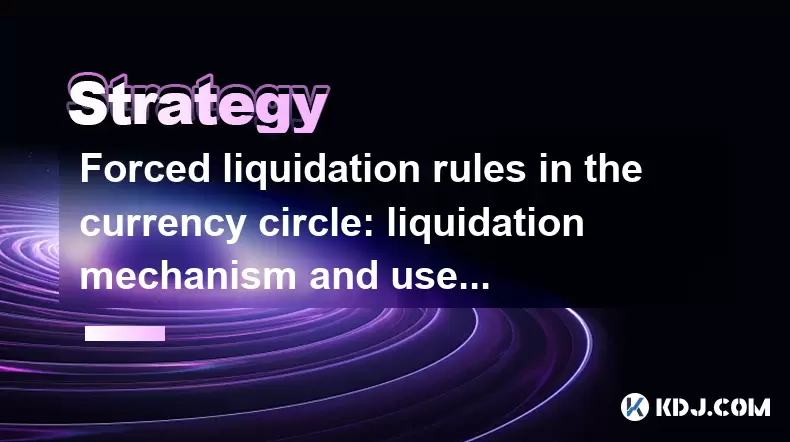-
 bitcoin
bitcoin $112195.049338 USD
2.42% -
 ethereum
ethereum $4124.915858 USD
2.81% -
 tether
tether $1.000570 USD
0.02% -
 xrp
xrp $2.861568 USD
2.25% -
 bnb
bnb $1000.346670 USD
3.04% -
 solana
solana $209.070819 USD
3.38% -
 usd-coin
usd-coin $0.999870 USD
0.02% -
 dogecoin
dogecoin $0.235379 USD
2.65% -
 tron
tron $0.335681 USD
-0.20% -
 cardano
cardano $0.803501 USD
3.38% -
 hyperliquid
hyperliquid $47.120881 USD
3.56% -
 chainlink
chainlink $21.501300 USD
3.44% -
 ethena-usde
ethena-usde $1.000571 USD
0.02% -
 avalanche
avalanche $29.793378 USD
3.62% -
 stellar
stellar $0.366964 USD
2.42%
Forced liquidation rules in the currency circle: liquidation mechanism and user response strategy
Forced liquidation in crypto occurs when a trader's position is closed by the exchange due to insufficient margin, protecting both parties from further losses.
Jun 07, 2025 at 10:35 am

Forced liquidation in the cryptocurrency world is a critical mechanism that traders must understand to navigate the volatile markets effectively. Liquidation occurs when a trader's position is closed by the exchange due to insufficient margin to cover potential losses. This process is automatic and designed to protect both the trader and the exchange from further financial damage. Understanding the rules and mechanisms of forced liquidation is essential for any trader looking to manage risk and maintain their positions in the market.
Understanding Forced Liquidation
Forced liquidation is triggered when the value of a trader's position moves against them, and their account balance falls below the maintenance margin requirement set by the exchange. The maintenance margin is the minimum amount of equity a trader must maintain in their account to keep their positions open. If the account balance drops below this threshold, the exchange will initiate a liquidation to close the position and prevent further losses.
The process of liquidation involves the exchange selling off the trader's assets at the current market price. This can sometimes lead to a cascade effect where multiple liquidations occur simultaneously, causing increased volatility in the market. It's important for traders to be aware of the potential for such events and to manage their positions accordingly.
Liquidation Mechanism
The liquidation mechanism varies slightly from one exchange to another, but the core principles remain the same. When a trader's position is at risk of liquidation, the exchange will typically send a margin call to the trader, giving them a chance to deposit more funds and restore their account to the required margin level. If the trader fails to meet the margin call within the specified time frame, the exchange will proceed with the liquidation.
The liquidation process is executed by the exchange's risk management system, which automatically closes the trader's position at the best available market price. This is done to minimize the loss for both the trader and the exchange. However, in highly volatile markets, the best available price may still result in significant losses for the trader.
Factors Influencing Liquidation
Several factors can influence the likelihood of a forced liquidation. Leverage is a key factor, as higher leverage increases the risk of liquidation. When traders use leverage to amplify their positions, even small market movements can result in significant changes to their account balance. Volatility is another critical factor, as rapid price changes can quickly push an account into a liquidation scenario.
Additionally, the size of the position relative to the trader's account balance can impact the risk of liquidation. Larger positions require more capital to maintain, and if the market moves against the trader, the account may quickly fall below the maintenance margin. It's crucial for traders to carefully consider these factors when opening new positions.
User Response Strategies
To mitigate the risk of forced liquidation, traders can employ several strategies. One effective approach is to use stop-loss orders, which automatically close a position when the market reaches a certain price level. This can help limit losses and prevent the account from falling below the maintenance margin.
Another strategy is to regularly monitor the account balance and adjust positions accordingly. If the market is moving against a position, traders can deposit additional funds to meet the margin requirements or reduce the size of their position to lower the risk of liquidation. Diversifying the portfolio can also help spread risk and reduce the impact of adverse market movements on any single position.
Managing Leverage
Leverage is a double-edged sword in trading. While it can amplify profits, it also increases the risk of liquidation. Traders should carefully consider the amount of leverage they use and ensure it aligns with their risk tolerance and trading strategy. Using lower leverage can provide a buffer against market volatility and reduce the likelihood of forced liquidation.
It's also important to understand the specific leverage rules of the exchange being used. Some exchanges may have different leverage limits for different assets or may adjust leverage based on market conditions. Traders should familiarize themselves with these rules to avoid unexpected liquidations.
Monitoring Market Conditions
Staying informed about market conditions is crucial for managing the risk of forced liquidation. Traders should keep an eye on market trends, news events, and other factors that could impact the price of their positions. By staying informed, traders can make more informed decisions about when to adjust their positions or deposit additional funds to meet margin requirements.
Using trading tools and platforms that offer real-time data and alerts can also help traders stay on top of market movements. These tools can provide valuable insights and help traders react quickly to changing market conditions, reducing the risk of forced liquidation.
Frequently Asked Questions
Q: Can I avoid forced liquidation entirely?A: While it's impossible to completely eliminate the risk of forced liquidation, traders can take steps to minimize it. Using stop-loss orders, monitoring account balances, and adjusting positions based on market conditions can help reduce the likelihood of liquidation. Additionally, using lower leverage and diversifying the portfolio can provide a buffer against market volatility.
Q: What happens to my assets during a forced liquidation?A: During a forced liquidation, the exchange will sell your assets at the current market price to close your position. The proceeds from the sale are used to cover any losses and fees associated with the liquidation. Any remaining funds are returned to your account. It's important to note that in highly volatile markets, the sale price may be lower than expected, resulting in greater losses.
Q: How can I recover from a forced liquidation?A: Recovering from a forced liquidation involves reassessing your trading strategy and risk management practices. Start by reviewing the factors that led to the liquidation and adjusting your approach accordingly. This may include using lower leverage, setting tighter stop-loss orders, and diversifying your portfolio. It's also important to ensure you have sufficient capital to meet margin requirements and to continue trading.
Q: Are there any warning signs that a forced liquidation is imminent?A: Yes, there are several warning signs that a forced liquidation may be approaching. Receiving a margin call from the exchange is a clear indication that your account is at risk. Additionally, if you notice your account balance approaching the maintenance margin level, it's a sign that you may need to deposit additional funds or adjust your positions. Monitoring market volatility and the performance of your positions can also help you anticipate potential liquidation scenarios.
Disclaimer:info@kdj.com
The information provided is not trading advice. kdj.com does not assume any responsibility for any investments made based on the information provided in this article. Cryptocurrencies are highly volatile and it is highly recommended that you invest with caution after thorough research!
If you believe that the content used on this website infringes your copyright, please contact us immediately (info@kdj.com) and we will delete it promptly.
- Solana: Institutions' Growing Confidence Signals a Bullish Future
- 2025-09-29 17:05:16
- PumpFun (PUMP) Price in October: Will the Memecoin Momentum Continue?
- 2025-09-29 16:25:14
- Cloud Mining, High-Yield Contracts, and Market Volatility: A New Yorker's Take
- 2025-09-29 17:05:16
- Royal Mint Error Coins: What's the Sell Price?
- 2025-09-29 16:25:14
- BABY Token Inflation and Co-Staking: A New Era for Babylon
- 2025-09-29 17:10:01
- Dogecoin, ETFs, and Memecoins: Navigating the Hype in the Wild World of Crypto
- 2025-09-29 17:10:01
Related knowledge

Practical parameter settings for a Bitcoin multi-timeframe moving average system
Sep 18,2025 at 10:54pm
Optimizing Timeframe Combinations for Bitcoin Trading1. Selecting appropriate timeframes is crucial when building a multi-timeframe moving average sys...

How can I filter out false breakouts in Dogecoin high-frequency trading?
Sep 22,2025 at 01:00am
Understanding False Breakouts in Dogecoin Trading1. A false breakout occurs when Dogecoin's price appears to move beyond a defined support or resistan...

Techniques for identifying tops and bottoms in the Bitcoin on-chain NVT model
Sep 20,2025 at 07:54pm
Understanding the NVT Model in Bitcoin Analysis1. The Network Value to Transactions (NVT) ratio is often described as the 'P/E ratio' of the cryptocur...

What does the surge in open interest in Bitcoincoin futures mean?
Sep 20,2025 at 11:18pm
Understanding the Surge in Dogecoin Futures Open Interest1. A surge in open interest within Dogecoin futures indicates a growing number of active cont...

How can I use the Ethereum USDT premium to gauge market sentiment?
Sep 18,2025 at 11:55pm
Understanding the Ethereum USDT Premium1. The Ethereum USDT premium refers to the price difference between USDT (Tether) traded on Ethereum-based plat...

What should I do if Ethereum staking yields decline?
Sep 20,2025 at 06:18am
Understanding the Causes Behind Declining Ethereum Staking Yields1. The Ethereum network transitioned to a proof-of-stake consensus mechanism with the...

Practical parameter settings for a Bitcoin multi-timeframe moving average system
Sep 18,2025 at 10:54pm
Optimizing Timeframe Combinations for Bitcoin Trading1. Selecting appropriate timeframes is crucial when building a multi-timeframe moving average sys...

How can I filter out false breakouts in Dogecoin high-frequency trading?
Sep 22,2025 at 01:00am
Understanding False Breakouts in Dogecoin Trading1. A false breakout occurs when Dogecoin's price appears to move beyond a defined support or resistan...

Techniques for identifying tops and bottoms in the Bitcoin on-chain NVT model
Sep 20,2025 at 07:54pm
Understanding the NVT Model in Bitcoin Analysis1. The Network Value to Transactions (NVT) ratio is often described as the 'P/E ratio' of the cryptocur...

What does the surge in open interest in Bitcoincoin futures mean?
Sep 20,2025 at 11:18pm
Understanding the Surge in Dogecoin Futures Open Interest1. A surge in open interest within Dogecoin futures indicates a growing number of active cont...

How can I use the Ethereum USDT premium to gauge market sentiment?
Sep 18,2025 at 11:55pm
Understanding the Ethereum USDT Premium1. The Ethereum USDT premium refers to the price difference between USDT (Tether) traded on Ethereum-based plat...

What should I do if Ethereum staking yields decline?
Sep 20,2025 at 06:18am
Understanding the Causes Behind Declining Ethereum Staking Yields1. The Ethereum network transitioned to a proof-of-stake consensus mechanism with the...
See all articles










































































